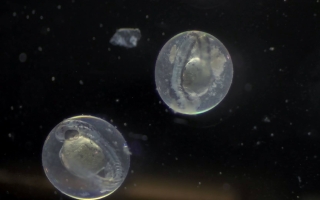Full Name
Joshua Rosenthal
Title
Senior Scientist

- Email:
- Phone:
- Fax:
- CV:
- ORCID ID:
N/A
B.S. Biology, Haverford College, 1985
Dr. Joshua Rosenthal’s research spans molecular biology and neurobiology, with an interest in processes that modify genetic information in nucleic acids. RNA editing by adenosine deamination is the main focus of his research program, a process that occurs in all multicellular animals. Unlike alternative splicing, which shuffles relatively large regions of RNA, editing precisely targets single bases. Catalyzed by the ADAR family of enzymes, adenosines are converted to inosine at specific positions within RNAs. Although inosine is not one of the four Watson-Crick bases, it is a biological mimic for guanosine during translation. Thus, when editing occurs within messenger RNAs, it can recode specific codons, leading to changes to protein structure and function. Rosenthal and coworkers discovered that cephalopods recode mRNAs at unprecedented levels using this mechanism. Ongoing projects seek to understand how these organisms are modifying their genetic information in response to environmental cues, and what about their RNA editing machinery explains its heightened activity. Early on, Rosenthal recognized that RNA editing carried tremendous potential as a mechanism for human therapeutics. His group developed one of the first systems to redirect RNA editing enzymes to new targets in human cells. Using these ideas, he co-founded Korro Bio (https://www.korrobio.com) , a biotech start-up in Cambridge MA, and oversees projects in his lab that use directed RNA editing as a therapy for genetic disease, chronic pain, and cancer. Finally, Rosenthal also leads efforts at the MBL to make genetically tractable cephalopod models to stimulate research using these organisms. Recently, they have developed the first defined cephalopod lines harboring gene knockouts via CRISPR.
Ohja, N., Diaz Quiroz J.F. and Rosenthal, J.J.C. (2021). In vitro and in cellula site-directed RNA editing using the λNDD-BoxB system. Methods in Enzymology. 658: 335-358. https://doi.org/10.1016/bs.mie.2021.06.009
Crawford, K, Diaz Quiroz, J.F., Koenig, C.M., Ahuja, N., Albertin, C.B. and Rosenthal, J.J.C. (2020). Highly efficient knockout of a squid pigmentation gene. Curr. Biol. 30: 3484-3490. doi: 10.1016/j.cub.2020.06.099.
Vallecillo-Viejo, I.C., Liscovitch-Brauer, N., Diaz Quiroz, J.F., Montiel-Gonzalez, M.F., Nemes, S., Rangan, K.J., Levinson, S.R., Eisenberg, E. and Rosenthal, J.J.C. (2020). Spatially regulated editing of genetic information within a neuron. Nucl. Acids. Res. 48:3999-4012. doi: 10.1093/nar/gkaa172.
Montiel-Gonzalez, M, Diaz-Quiroz, J and Rosenthal, J.J.C. (2018). Current Strategies for Site-Directed RNA editing using ADARs. Methods. 156: 16-24.
Vallecillo-Viejo, I., Liscovitch-Brauer, N., Montiel-Gonzalez, M.F., Eisenberg, E. and Rosenthal, J.J.C. (2018). Abundant off-target edits from site-directed RNA editing can be reduced by nuclear localization of the editing enzyme. RNA Biol. 15: 104-114. DOI: 10.1080/15476286.2017.1387711.
Liscovitch-Brauer, N., Alon, S., Porath, H.T., Elstein, B., Unger, R., Ziv, T., Admon, A., Levanon, E.Y., Rosenthal, J.J.C.*, and Eisenberg, E.* (2017). Trade-off between transcriptome plasticity and genome evolution in cephalopods. Cell. 169:191-202 (* co-communicating authors).
M.F. Montiel-Gonzalez, I.C. Vallecillo-Viejo, and J.J.C. Rosenthal (2016). An efficient system for selectively altering genetic information in mRNAs. Nucl. Acids. Res. 44: e157.
S. Alon, S.C. Garrett, E.Y. Levanon, S. Olson, B.R. Graveley, J.J.C. Rosenthal, and E. Eisenberg (2015). The majority of transcripts in the squid nervous system are extensively recoded by A-to-I RNA editing. eLife 4: 10.7554/eLife.05198.
M. Montiel-Gonzalez, I. Vallecillo, G. Yudowski, and J.J.C. Rosenthal (2013). Correction of mutations within the cystic fibrosis transmembrane conductance regulator by site-directed RNA editing. PNAS 110: 18285-90.
J.J.C. Rosenthal and P.H. Seeburg (2012). A-to-I RNA Editing: Effects on Proteins Key to Neural Excitability. Neuron. 74:432-9.
S.C. Garrett and J.J.C. Rosenthal (2012). RNA editing underlies temperature adaptation in K+ channels from polar octopuses. Science. 335: 848-51.









